Utilizing UV Flashlights for Effective Pest Control
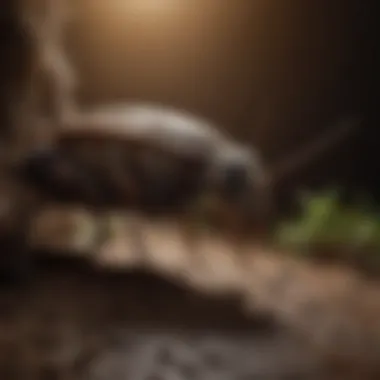

Intro
Managing pests in residential settings poses significant challenges for homeowners. Traditional pest control methods often rely on chemical treatments that can be both harmful to human health and the environment. This article explores an innovative approach using UV flashlights for pest management. By understanding how these devices operate and their effectiveness against various pests, you can make informed decisions about pest control strategies.
With increasing interest in sustainable living, many are looking for eco-friendly solutions. UV flashlights provide an effective, low-impact option to detect and eliminate pests without relying on harsh chemicals. This advances both personal safety and environmental concerns.
Understanding Pests
Pests can be defined as organisms that interfere with human activities. They may damage property, transmit diseases, or create discomfort. Common household pests include insects such as cockroaches, ants, and flies, as well as rodents.
Importance of Pest Identification
Identifying pests is a crucial step in any control method. Different pests require different methods of management based on their behavior, habitat, and biology. Understanding the specific characteristics of the pests you face enables focused strategies that increase effectiveness.
How UV Flashlights Work
UV flashlights emit ultraviolet light, which is invisible to the human eye. Many pests are attracted to UV light, making these devices useful for detection. When used effectively, UV flashlights can illuminate hidden critters, making it easier to target them for eradication.
Effectiveness Against Specific Pests
Certain pests are especially responsive to UV light. For example:
- Insects: Many insects use visual cues for navigation, making them particularly inclined to fly towards UV sources.
- Rodents: While not inherently attracted to UV light, the illumination can expose their nests and hiding places.
Advantages Over Traditional Methods
Utilizing UV flashlights provides several advantages over conventional pest control:
- Safety: Reduces exposure to potentially toxic chemicals.
- Targeted Elimination: Enables focused strategies on specific pest populations.
- Cost-Effective: UV flashlights are relatively inexpensive and can reduce long-term pest control costs.
Practical Implementation
To incorporate UV flashlights into your pest control routine, consider the following steps:
- Identify Problem Areas: Use the flashlight in areas where pests are noticed, such as kitchens or basements.
- Observe: Look for insects drawn to the light, revealing their locations.
- Follow Up: Combine this method with traps or other removal techniques for best results.
Preface to UV Flashlight Technology
The utilization of UV flashlights represents a significant advancement in the realm of pest control. This section sheds light on the fundamental aspects of UV flashlight technology, its operational principles, and its relevance in effectively managing pest infestations. It is crucial to comprehend how these devices function to appreciate their role in modern pest management strategies.
Understanding Ultraviolet Light
Ultraviolet light is a form of electromagnetic radiation that has wavelengths shorter than visible light but longer than X-rays. It is divided into three categories based on its wavelength: UVA, UVB, and UVC. Each type of UV light has different properties and applications, especially in pest control.
UVA, for instance, is widely used due to its effectiveness in attracting certain insects. It can help homeowners identify infestations by highlighting areas where pests are likely present. UVB, which is generally more harmful to living organisms, has less utility in pest control but may be useful in sterilization processes. UVC is particularly known for its germicidal properties. Understanding these different types is essential for selecting the right UV flashlight for specific pest control needs.
Types of UV Flashlights
There are several types of UV flashlights that vary in their applications and effectiveness. Knowing these helps consumers make informed choices when addressing pest issues.
UV-A Flashlights
UV-A flashlights emit ultraviolet light primarily within the UVA spectrum. They are particularly effective for attracting and monitoring pests, such as insects. One key characteristic of UV-A flashlights is their ability to illuminate specific organic materials, which can be useful for locating bed bugs and other nocturnal pests. This trait makes them a popular choice among homeowners looking to manage infestations without harsh chemicals.
The unique feature of UV-A flashlights is their low energy output, making them safe for continuous use indoors. However, their effectiveness may be limited against pests that are not attracted to UVA light, necessitating a combination of methods for comprehensive pest control.
UV-B Flashlights
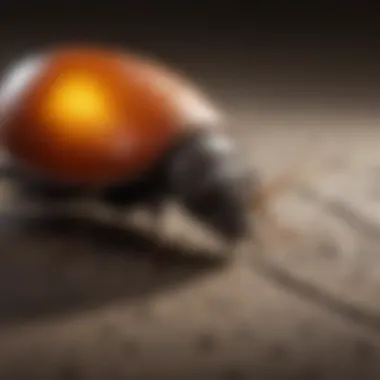
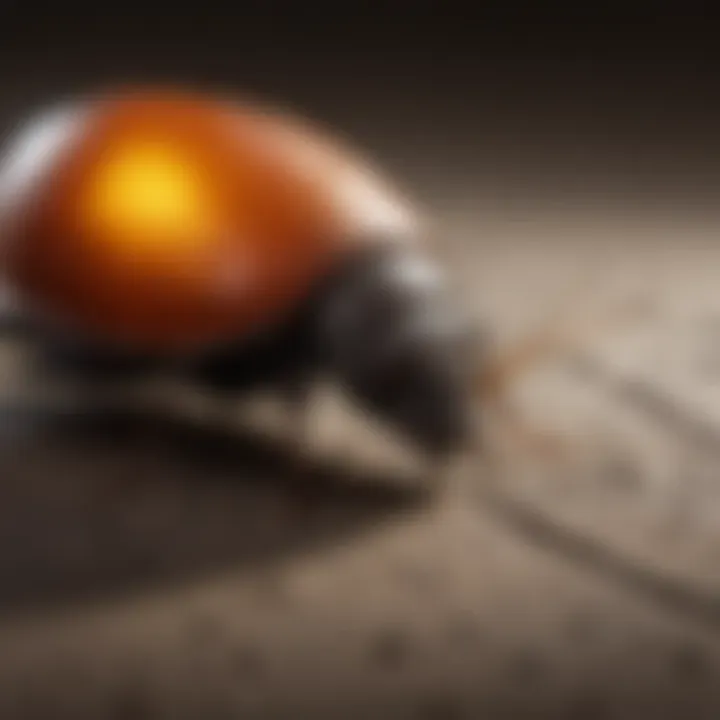
UV-B flashlights operate with a different aspect of ultraviolet light, focusing on wavelengths that can cause harm to organisms. Although not commonly used in everyday pest control, they can have specific applications in agricultural contexts to manage crops. The weakest from a pest control perspective, their use is mostly limited to certain sterilization processes or specific environment conditions.
One major disadvantage is the potential harm they can cause to both pets and humans if misused. Their effectiveness is less reliable compared to UVA counterparts, making them less favored in typical household applications.
UV-C Flashlights
UV-C flashlights are recognized for their powerful disinfecting properties. They emit short wavelengths which can destroy the DNA of microorganisms, making it a potential tool for sanitizing areas affected by pests, especially where diseases may spread. This type is increasingly noted for its role in creating safer environments in residential and healthcare settings.
A unique feature of UV-C is its ability to neutralize bacteria and viruses, thus adding a layer of protection against health issues associated with pest infestations. However, the high-intensity radiation can be harmful, necessitating stringent safety measures during its use. This makes UV-C flashlights more suitable for controlled applications rather than general pest control in a home setting.
The different types of UV flashlights cater to various pest management needs, each offering unique features and considerations for effective use.
Understanding these distinctions is essential for homeowners seeking effective solutions. Making an informed choice between UV-A, UV-B, and UV-C flashlights can significantly enhance pest control efforts, providing a modern alternative to traditional chemical methods.
Mechanism of Action in Pest Control
Understanding the mechanism of action of UV flashlights in pest control is crucial. This section examines the ways in which UV light affects pests and how it can be used effectively in pest management. It helps illuminate the processes behind their efficacy, allowing homeowners to grasp the benefits and potential drawbacks of these tools.
How UV Light Affects Pests
Ultraviolet light, in its various forms, disrupts biological processes in insects. It can damage the DNA of pests, leading to mutations or even death. When pests are exposed to UV light, the intensity and wavelength play a significant role. UV-A light, for instance, penetrates deeper into the insect's biological structure than other types of UV light.
Research shows that certain wavelengths can be particularly harmful to common pests. For example, UV-C light is known to effectively kill bacteria and viruses, but its damage doesn't stop there. It can harm pests that come into contact with it. Through various studies, exposure times and light intensity have been analyzed to optimize effectiveness. Using these insights, homeowners can better understand how to employ UV flashlights to their advantage.
Attraction and Confusion of Insects
Insects are often attracted to UV light. Many species rely on specific visual cues to navigate and find food. UV flashlights can mimic certain natural light sources, effectively drawing insects closer. This attraction can be harnessed strategically for pest control.
When an insect approaches a UV light source, the resulting confusion may lead to inappropriate behavior. For instance, flying insects such as moths will circle the light, sometimes leading them into traps. This behavioral manipulation can simplify the pest control process.
Important Note: UV flashlights are not a silver bullet. They do not replace conventional methods of pest control but work best when integrated into a comprehensive pest management strategy.
The effective use of UV flashlights requires consideration of various factors, including the types of pests targeted and how often to use the flashlights. Balancing light intensity and duration can yield better outcomes. Homeowners must also ensure that any other pest control methods do not interfere with the effectiveness of UV light.
Through these mechanisms, UV flashlights present a novel approach that should not be overlooked when tackling pest issues.
Effective Pests Targeted by UV Flashlights
Understanding the different pests that UV flashlights can effectively target is crucial in harnessing their potential for pest control. This knowledge helps homeowners make informed decisions about pest management strategies. The use of UV flashlights is becoming a popular topic among those seeking innovative solutions to their pest problems. The ability to detect and manipulate pests using light not only enhances efficiency but also minimizes the reliance on chemical treatments, which is beneficial for households, especially those with children and pets.
Common Household Pests
Bed Bugs
Bed bugs are small, elusive insects that have gained notoriety for their resilience and ability to hide in small crevices. Their presence often leads to substantial discomfort due to their bites, triggering allergic reactions in many individuals. UV flashlights can assist in identifying infested areas by revealing the telltale signs of bed bug presence. This is vital because conventional methods can sometimes miss the early stages of an infestation. The unique feature of bed bugs is their ability to lay numerous eggs quickly, leading to rapid population growth. Hence, early detection becomes essential in controlling them effectively.
Fleas
Fleas are another significant pest found in homes, particularly where pets are present. They are known for their speed and agility, making them difficult to catch. The contribution of UV flashlights comes in their role in detecting flea infestations. Fleas are attracted to UV light, which can help homeowners spot them more easily before they become a full-blown problem. A key characteristic of fleas is their lifecycle, which can quickly escalate an issue if not addressed promptly. Their ability to jump several times their body length makes traditional pest control methods less effective in some cases. Thus, when it comes to efficacy, UV flashlights serve as a prompt detection system for these pesky insects.
Moths
Moths, particularly those that are drawn to light, can become a nuisance in homes, especially during warmer months. This visibility makes them a prime target for UV flashlights, as the light can lure them out of hiding spots. Moths are commonly attracted to light sources, and utilizing this behavior can help reduce their numbers significantly. However, the challenge lies in distinguishing between beneficial moth species and harmful ones, as many play important roles in the ecosystem. Therefore, while UV flashlights can be effective for monitoring and managing moth populations, the specific targeting of harmful species requires additional knowledge.
Agricultural Applications
Aphids
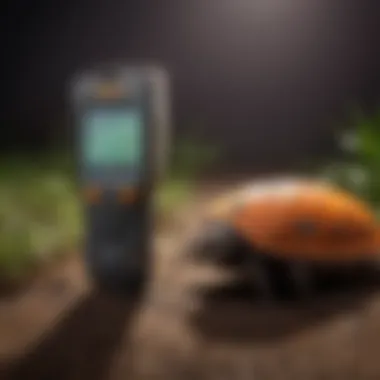
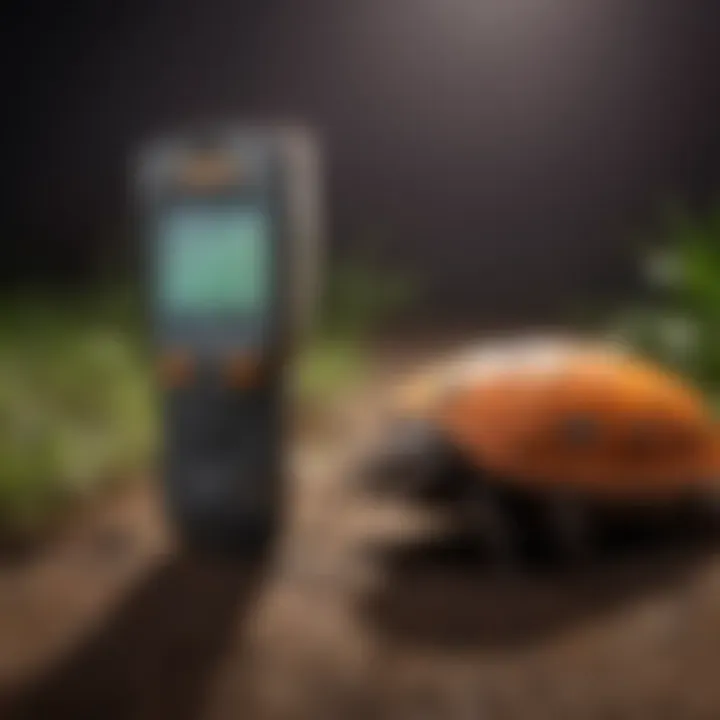
Aphids are among the most common pests affecting crops, notably cause damage by feeding on plant sap. Their presence can lead to significant yield losses, making them a priority for farmers. UV flashlights are effective in identifying aphid populations early in the growing season. They can attract and reveal these pests, allowing for timely interventions. The key characteristic of aphids is their rapid reproduction. In only one generation, a small number can multiply into thousands. This accelerates the urgency in pest management, as farmers need clear and immediate action plans to address potential infestations.
Whiteflies
Whiteflies are another agricultural nuisance, especially affecting greenhouse plants. They share a unique feature with aphids in their ability to reproduce rapidly, contributing to out-of-control populations if not handled accordingly. UV light can effectively lure adult whiteflies, making it easier for farmers to gauge their presence and implement control measures. The transparency of whiteflies and their habits of flying can complicate their detection. However, integrating UV flashlights into monitoring routines can simplify this process.
Spider Mites
Spider mites are tiny pests that can be incredibly destructive to a variety of crops. Their presence often goes unnoticed until significant damage is done. The use of UV flashlights can highlight the webbing and damage they leave behind. Moreover, they are less energetic than other pests, often found, hiding on the underside of leaves. This ability to target their usual hiding spots makes UV light a practical and effective tool. The unique behaviors of spider mites necessitate precise detection, and UV flashlights help bridge that gap for efficient pest management.
Benefits of Using UV Flashlights
The use of UV flashlights in pest control presents numerous advantages that are particularly noteworthy for homeowners looking for effective solutions. Traditional pest control methods often involve chemicals that can be harmful to both the environment and the surrounding living space. In contrast, UV flashlights offer a non-toxic alternative that can be just as effective, if not more so, in managing pest populations.
Non-Toxic Pest Control
One of the primary benefits of employing UV flashlights for pest control is their non-toxic nature. Many conventional pest control measures utilize harsh chemicals that can pose risks to individuals, pets, and wildlife. UV light, on the other hand, is a physical method that does not rely on any hazardous substances. Pests such as bed bugs, fleas, and moths are drawn to UV light and can be effectively observed and targeted without introducing toxins into the environment.
Using UV flashlights for pest control is particularly advantageous for households with children or pets. Parents and pet owners often seek ways to protect their loved ones from harmful chemicals. By utilizing UV flashlights, families can implement pest control measures while minimizing the risks associated with traditional pesticides.
Not only does this non-toxic approach foster a safer living space, but it also aligns with a growing trend toward sustainable living. As more households aim to reduce their environmental footprint, integrating UV flashlights into pest management strategies can be a small yet impactful step toward achieving that goal.
Cost-Effectiveness Compared to Traditional Methods
Another significant advantage of UV flashlights is their cost-effectiveness. In the realm of pest control, homeowners often encounter recurring costs associated with chemical treatments and professional extermination services. These methods can accumulate over time, not to mention the potential costs tied to damage caused by infestations. For instance, the replacement of furniture or damage to structural components can quickly add up.
In contrast, UV flashlights represent a one-time investment that can yield long-term savings. Once purchased, these tools can be used repeatedly without ongoing expenses. Homeowners can conduct regular inspections and treatments as needed, reducing reliance on expensive traditional pest control options.
Furthermore, the effectiveness of UV flashlights in attracting and identifying pests can lead to earlier detection of infestations. Early intervention typically results in less severe problems, which translates to fewer expenses in resolving pest issues.
In summary, the use of UV flashlights not only provides a non-toxic solution but also proves to be a cost-effective strategy for pest control.
Limitations and Considerations
Understanding the limitations and considerations of using UV flashlights for pest control is crucial for homeowners. While UV flashlights offer innovative approaches to managing pests, they are not without their shortcomings. Recognizing these limitations can empower users to make informed decisions and use UV technology more effectively.
Effectiveness Against Certain Types of Pests
UV flashlights are effective against various pests but not all. First, it is essential to understand that some insects are more attracted to UV light than others. For instance, moths and certain beetles display noticeable behavior towards UV wavelengths. However, household pests like cockroaches and ants may not react similarly. This difference stems from their attraction instincts and natural behaviors, which do not always correlate with UV light.
Moreover, the effectiveness of UV flashlights can depend on environmental conditions. In environments with bright natural or artificial light, the visibility of UV light diminishes. Therefore, your pest control strategy may be less effective in well-lit areas. Homeowners should assess their environment and combine UV treatments with other pest management methods for desired outcomes.
Safety Precautions for Users
While UV flashlights are a powerful tool, safety should not be overlooked. Proper handling is imperative to prevent exposure to UV rays. Here are essential precautions to consider:
- Wear protective eyewear: UV rays can harm the eyes. It is strongly advised to use goggles designed for UV protection to avoid any potential damage.
- Limit skin exposure: Prolonged exposure to UV light, even indirect, can harm skin. Use gloves and long-sleeved clothing to minimize bare skin contact.
- Avoid direct beam exposure: Aim the UV flashlight away from yourself and others. This practice helps limit unwanted accidents or injuries.
Furthermore, consider the bounds of use in spaces where pets and children may be present. While UV light itself is not harmful in moderation, being cautious about their exposure to flashing lights can enhance safety.
Practical Implementation Strategies
When considering the effectiveness of UV flashlights in pest control, practical implementation strategies become crucial. These strategies outline how to effectively utilize UV technology in real-life scenarios. They ensure that house owners and housewives can maximize the benefits of this innovative tool.
Using UV flashlights is not merely about possessing the technology. It involves strategic application tailored to specific needs. Key benefits of practical implementation strategies include improved detection of pests, enhanced efficiency in treatments, and safety for users and other non-target species. All these aspects contribute to a more effective pest control approach.
Using UV Flashlights for Inspection

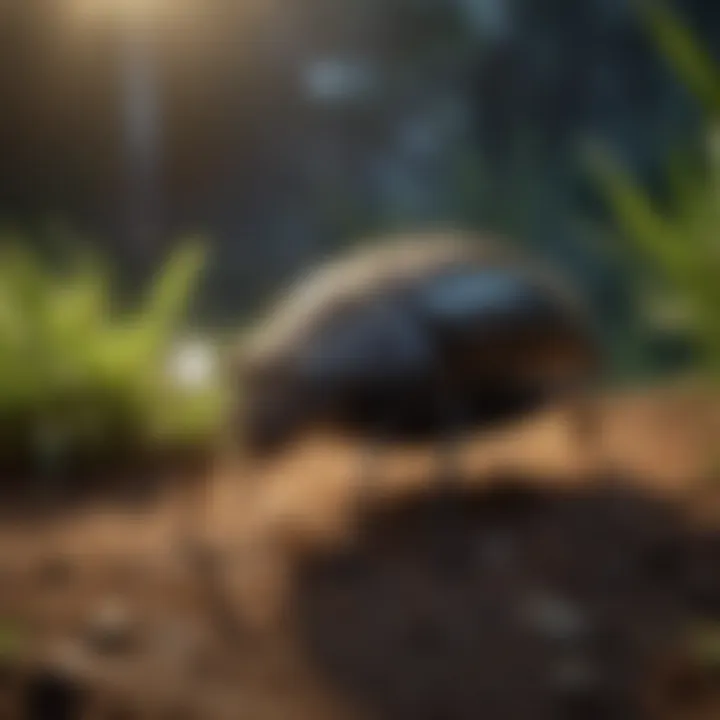
The first step in pest control is identifying the problem. UV flashlights are valuable for inspection purposes. Their light reveals hidden pests that are otherwise difficult to detect with the naked eye. Common areas to inspect include dark corners, behind furniture, and along baseboards. Using the flashlight in these places can uncover signs of infestations, like bed bugs or fleas, hidden from view.
To use a UV flashlight effectively for inspection, consider the following steps:
- Set the Lighting: Ensure the surrounding area is dark to enhance the flashlight's effect.
- Survey Key Areas: Focus on likely pest hiding spots—under beds, inside closets, and near pet bedding.
- Look for Fluorescence: Many pests signal their presence through visible fluorescence under UV light. This can be particularly effective for spotting specific types of insects and their droppings.
Regular inspections can lead to early detection, which is vital for preventing larger infestations. This proactive approach saves time and money.
Integrating UV Flashlights into Pest Control Routines
Integration of UV flashlights into existing pest control routines elevates their effectiveness. This can enhance the efficacy of conventional methods while minimizing chemical usage. By combining approaches, house owners can adopt a more holistic strategy to pest management.
Here are some ways to integrate UV flashlights:
- Routine Inspections: Incorporate the use of UV lights in your regular cleaning schedules. Treat it as an essential part of maintaining your home.
- Follow-Up Treatments: After applying traditional pest control methods, use the UV flashlight to find any remaining pests. This can be particularly helpful in assessing the success of treatments and guiding further actions.
- Educate Household Members: Teach others in the home how to use the UV flashlight for inspections. Encourage collaboration on maintaining a pest-free living space.
Ecological Impact of UV Pest Control Methods
The application of ultraviolet (UV) flashlights in pest control does not exist in a vacuum; it has broader implications for the environment. Understanding the ecological impact of these methods is crucial for homeowners and pest control practitioners alike. As pest management evolves, the need for solutions that do not compromise ecological integrity becomes increasingly important. This section will discuss the effects on non-target species and the role of UV flashlights in sustainable pest management practices.
Impact on Non-Target Species
One significant aspect of using UV flashlights for pest control is the potential impact on non-target species. These are organisms that are not the intended targets of pest control measures but may still be affected by them. Non-target species can include beneficial insects, such as pollinators and predators of pest species.
When UV light attracts certain pests, it may do so inadvertently for other insects, raising concerns. For example, while the flashlight can efficiently draw in moths or beetles, it might also impact butterflies or bees that are drawn to the same light.
To minimize such risks, some strategies can be integrated:
- Targeted Use: Focus on using UV flashlights in specific areas known for severe pest issues, reducing broader exposure.
- Time of Use: Operate flashlights during specific hours when non-target species are less active, often at night.
- Integration with Other Strategies: Combine UV light with other pest control methods that do not affect beneficial organisms.
Awareness of these impacts will help homeowners make informed decisions about their pest control practices.
Role in Sustainable Pest Management Practices
The role of UV flashlights in sustainable pest management is multifaceted. These methods can significantly contribute to an overall ecological balance. By using UV light, homeowners can adopt a system that not only controls pests effectively but also aligns with environmental sustainability goals.
- Reduction of Chemical Dependence: Traditional pest control often relies heavily on chemical insecticides, which can have harmful effects on the environment. UV flashlights provide a non-toxic option, minimizing the need for these chemicals. A shift towards relying more on physical barriers such as UV light can lead to healthier ecosystems.
- Enhancing Biocontrol Methods: UV flashlights can complement biological control methods. For example, certain UV light frequencies may enhance the effectiveness of natural predators by making them more visible. This can allow beneficial species to thrive while keeping pest populations in check.
- Monitoring Ecosystem Health: UV flashlights can also be used as a tool for monitoring pest populations without causing extensive disruption. This can facilitate better planning and response strategies that respect ecological balance.
It is crucial to continuously assess the effects of pest control methods on the ecosystem to ensure a sustainable future.
By adopting UV flashlights, homeowners can contribute to a more sustainable approach, ultimately benefiting both their immediate environment and the broader ecosystem.
Concluding Thoughts on UV Flashlights in Pest Control
The relevance of the topic of UV flashlights in pest control cannot be understated. As the scope of pest management evolves, many householders seek non-toxic and effective methods to deal with infestations. Utilizing UV flashlights offers a fresh perspective, providing an efficient alternative to traditional pest control practices. Their unique ability to detect and manage pests presents a practical solution, especially for common home invaders like bed bugs and fleas.
The integration of UV flashlights in pest control not only enhances detection but also aligns with sustainability concerns. It minimizes dependency on harmful chemicals that pose risks to humans, pets, and the environment. Homeowners can appreciate this eco-friendliness along with the effectiveness of UV flashlights. Understanding and implementing these tools can lead to significant improvements in pest management strategies, making homes safer and cleaner.
"The future of pest management pivots towards innovative technologies like UV flashlights, emphasizing effectiveness and ecological responsibility."
Summary of Effectiveness
In summarizing the effectiveness of UV flashlights, it is essential to note their ability to draw in pests attracted to ultraviolet light. This characteristic applies to numerous insect species that are naturally susceptible to UV detection. Research suggests that insects such as moths and various types of flies demonstrate heightened sensitivity to these wavelengths.
Moreover, their ability to expose bed bugs hiding in dark crevices creates a significant edge for homeowners. The combined aspects of attraction and effective detection paint a promising picture for pest control. The practicality of being able to visually inspect for pests and to target them directly with UV light further adds to their effectiveness. Homeowners should consider these factors when employing UV technology for pest management in their residences.
Future Trends in Pest Management Technology
Looking towards the future, the trends in pest management technology indicate an increased reliance on advanced tools, including UV flashlights. As research progresses, enhanced UV technology is likely to emerge, offering improved effectiveness in pest attraction and elimination.
With ongoing developments in Xerography and LED technology, manufacturers can expect to introduce UV flashlights with adjustable wavelengths tailored for specific pests. This specificity could lead to more targeted interventions, minimizing nontarget organisms' impacts.
Additionally, the integration of smart technology could lead to UV flashlights equipped with sensors to detect pest infestations in real-time. Such devices would transform how homeowners address pest problems, enhancing their approach and response times. As public awareness of eco-friendly pest control increases, UV flashlights could play a pivotal role in shaping a safer, more sustainable pest management landscape.



